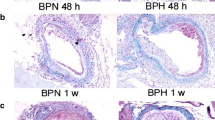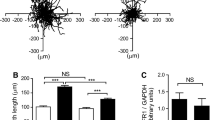Abstract
Phenotypic modulation (PM) of vascular smooth muscle cells (VSMCs) is central to the process of intimal hyperplasia which constitutes a common pathological lesion in occlusive vascular diseases. Changes in the functional expression of Kv1.5 and Kv1.3 currents upon PM in mice VSMCs have been found to contribute to cell migration and proliferation. Using human VSMCs from vessels in which unwanted remodeling is a relevant clinical complication, we explored the contribution of the Kv1.5 to Kv1.3 switch to PM. Changes in the expression and the functional contribution of Kv1.3 and Kv1.5 channels were studied in contractile and proliferating VSMCs obtained from human donors. Both a Kv1.5 to Kv1.3 switch upon PM and an anti-proliferative effect of Kv1.3 blockers on PDGF-induced proliferation were observed in all vascular beds studied. When investigating the signaling pathways modulated by the blockade of Kv1.3 channels, we found that anti-proliferative effects of Kv1.3 blockers on human coronary artery VSMCs were occluded by selective inhibition of MEK/ERK and PLCγ signaling pathways, but were unaffected upon blockade of PI3K/mTOR pathway. The temporal course of the anti-proliferative effects of Kv1.3 blockers indicates that they have a role in the late signaling events essential for the mitogenic response to growth factors. These findings establish the involvement of Kv1.3 channels in the PM of human VSMCs. Moreover, as current therapies to prevent restenosis rely on mTOR blockers, our results provide the basis for the development of novel, more specific therapies.








Similar content being viewed by others
References
Beech DJ (2007) Ion channel switching and activation in smooth-muscle cells of occlusive vascular diseases. Biochem Soc Trans 035:890–894
Beeton C, Wulff H, Standifer NE, Azam P, Mullen KM, Pennington MW, Kolski-Andreaco A, Wei E, Grino A, Counts DR, Wang PH et al (2006) Kv1.3 channels are a therapeutic target for T cell-mediated autoimmune diseases. Proc Natl Acad Sci U S A 103:17414–17419
Caglayan E, Vantler M, Leppänen O, Gerhardt F, Mustafov L, ten Freyhaus H, Kappert K, Odenthal M, Zimmermann WH, Tallquist MD, Rosenkranz S (2011) Disruption of platelet-derived growth factor-dependent phosphatidylinositol 3-kinase and phospholipase C γ1 activity abolishes vascular smooth muscle cell proliferation and migration and attenuates neointima formation in vivo. J Am Coll Cardiol 57:2527–2538
Cahalan MD, Chandy KG, DeCoursey TE, Gupta S (1985) A voltage-gated potassium channel in human T lymphocytes. J Physiol 358:197–237
Campbell GR, Campbell JH (1985) Smooth muscle phenotypic changes in arterial wall homeostasis: implications for the pathogenesis of atherosclerosis. Exp Mol Pathol 42:139–162
Chen TT, Luykenaar KD, Walsh EJ, Walsh MP, Cole WC (2006) Key role of Kv1 channels in vasoregulation. Circ Res 99:53–60
Cidad P, Jimenez-Perez L, Garcia-Arribas D, Miguel-Velado E, Tajada S, Ruiz-McDavitt C, Lopez-Lopez JR, Perez-Garcia MT (2012) Kv1.3 channels can modulate cell proliferation during phenotypic switch by an ion-flux independent mechanism. Arterioscler Thromb Vasc Biol 32:1299–1307
Cidad P, Moreno-Dominguez A, Novensa L, Roque M, Barquin L, Heras M, Perez-Garcia MT, Lopez-Lopez JR (2010) Characterization of ion channels involved in the proliferative response of femoral artery smooth muscle cells. Arterioscler Thromb Vasc Biol 30:1203–1211
DeCoursey TE, Chandy KG, Gupta S, Cahalan MD (1984) Voltage-gated K + channels in human lymphocyte-T—a role in mitogenesis. Nature 307:465–468
Eisen HJ, Tuzcu EM, Dorent R, Kobashigawa J, Mancini D, Valantine-von Kaeppler HA, Starling RC, Sörensen K, Hummel M, Lind JM, Abeywickrama KH et al (2003) Everolimus for the prevention of allograft rejection and vasculopathy in cardiac-transplant recipients. N Engl J Med 349:847–858
Erdogan A, Schaefer CA, Schaefer M, Luedders DW, Stockhausen F, Abdallah Y, Schaefer C, Most AK, Tillmanns H, Piper HM, Kuhlmann CR (2005) Margatoxin inhibits VEGF-induced hyperpolarization, proliferation and nitric oxide production of human endothelial cells. J Vasc Res 42:368–376
Formica RN Jr, Lorber KM, Friedman AL, Bia MJ, Lakkis F, Smith JD, Lorber MI (2004) The evolving experience using everolimus in clinical transplantation. Transplant Proc 36:S495–S499
Garcia-Calvo M, Leonard RJ, Novick J, Stevens SP, Schmalhofer W, Kaczorowski GJ, Garcia ML (1993) Purification, characterization, and biosynthesis of margatoxin, a component of Centruroides margaritatus venom that selectively inhibits voltage-dependent potassium channels. J Biol Chem 268:18866–18874
Hafizi S, Mordi VN, Andersson KM, Chester AH, Yacoub MH (2004) Differential effects of rapamycin, cyclosporine A, and FK506 on human coronary artery smooth muscle cell proliferation and signalling. Vasc Pharmacol 41:167–176
Hafizi S, Wang X, Chester AH, Yacoub MH, Proud CG (2004) ANG II activates effectors of mTOR via PI3-K signaling in human coronary smooth muscle cells. Am J Physiol Heart Circ Physiol 287:H1232–H1238
Hegle AP, Marble DD, Wilson GF (2006) A voltage-driven switch for ion-independent signaling by ether-a-go-go K + channels. Proc Natl Acad Sci U S A 103:2886–2891
Heldin CH, Westermark B (1999) Mechanism of action and in vivo role of platelet-derived growth factor. Physiol Rev 79:1283–1316
Hughes AD, Clunn GF, Refson J, Demoliou-Mason C (1996) Platelet-derived growth factor (PDGF): actions and mechanisms in vascular smooth muscle. Gen Pharmacol 27:1079–1089
Isoda K, Shiigai M, Ishigami N, Matsuki T, Horai R, Nishikawa K, Kusuhara M, Nishida Y, Iwakura Y, Ohsuzu F (2003) Deficiency of interleukin-1 receptor antagonist promotes neointimal formation after injury. Circulation 108:516–518
Jia L, Wang R, Tang DD (2012) Abl regulates smooth muscle cell proliferation by modulating actin dynamics and ERK1/2 activation. Am J Physiol Cell Physiol 302:C1026–C1034
Jones SM, Kazlauskas A (2001) Growth factor-dependent signaling and cell cycle progression. FEBS Lett 490:110–116
Jones SM, Kazlauskas A (2001) Growth-factor-dependent mitogenesis requires two distinct phases of signalling. Nat Cell Biol 3:165–172
Jurek A, Heldin CH, Lennartsson J (2011) Platelet-derived growth factor-induced signaling pathways interconnect to regulate the temporal pattern of Erk1/2 phosphorylation. Cell Signal 23:280–287
Kohler R, Wulff H, Eichler I, Kneifel M, Neumann D, Knorr A, Grgic I, Kampfe D, Si H, Wibawa J, Real R et al (2003) Blockade of the intermediate-conductance calcium-activated potassium channel as a new therapeutic strategy for restenosis. Circulation 108:1119–1125
Liou SF, Yeh JL, Liang JC, Chiu CC, Lin YT, Chen IJ (2004) Inhibition of mitogen-mediated proliferation of rat vascular smooth muscle cells by labedipinedilol-A through PKC and ERK 1/2 pathway. J Cardiovasc Pharmacol 44:539–551
Livak KJ, Schmittgen TD (2001) Analysis of relative gene expression data using real-time quantitative PCR and the 2(-Delta Delta C(T)) method. Methods 25:402–408
Miguel-Velado E, Moreno-Dominguez A, Colinas O, Cidad P, Heras M, Perez-Garcia MT, López-López JR (2005) Contribution of Kv channels to phenotypic remodeling of human uterine artery smooth muscle cells. Circ Res 97:1280–1287
Millership JE, Devor DC, Hamilton KL, Balut CM, Bruce JIE, Fearon IM (2011) Calcium-activated K + channels increase cell proliferation independent of K + conductance. Am J Physiol Cell Physiol 300:C792–C802
Millette E, Rauch BH, Kenagy RD, Daum G, Clowes AW (2006) Platelet-derived growth factor-BB transactivates the fibroblast growth factor receptor to induce proliferation in human smooth muscle cells. Trends Cardiovasc Med 16:25–28
Moreno-Dominguez A, Cidad P, Miguel-Velado E, Lopez-Lopez JR, Perez-Garcia MT (2009) De novo expression of Kv6.3 contributes to changes in vascular smooth muscle cell excitability in a hypertensive mice strain. J Physiol 587:625–640
Owens GK, Kumar MS, Wamhoff BR (2004) Molecular regulation of vascular smooth muscle cell differentiation in development and disease. Physiol Rev 84:767–801
Pardo LA (2004) Voltage-gated potassium channels in cell proliferation. Physiology 19:285–292
Roche S, Koegl M, Courtneidge SA (1994) The phosphatidylinositol 3-kinase alpha is required for DNA synthesis induced by some, but not all, growth factors. Proc Natl Acad Sci U S A 91:9185–9189
Roovers K, Assoian RK (2000) Integrating the MAP kinase signal into the G1 phase cell cycle machinery. Bioessays 22:818–826
Sabri A, Govindarajan G, Griffin TM, Byron KL, Samarel AM, Lucchesi PA (1998) Calcium- and protein kinase -dependent activation of the tyrosine kinase PYK2 by angiotensin II in vascular smooth muscle. Circ Res 83:841–851
Schmitz A, Sankaranarayanan A, Azam P, Schmidt-Lassen K, Homerick D, Hansel W, Wulff H (2005) Design of PAP-1, a selective small molecule Kv1.3 blocker, for the suppression of effector memory T cells in autoimmune diseases. Mol Pharmacol 68:1254–1270
Si H, Grgic I, Heyken WT, Maier T, Hoyer J, Reusch HP, Köhler R (2006) Mitogenic modulation of Ca2+-activated K+ channels in proliferating A7r5 vascular smooth muscle cells. Br J Pharmacol 148:909–917
Stehlik J, Edwards LB, Kucheryavaya AY, Benden C, Christie JD, Dipchand AI, Dobbels F, Kirk R, Rahmel AO, Hertz MI (2012) The registry of the international society for heart and lung transplantation: 29th official adult heart transplant report—2012. J Heart Lung Transplant 31:1052–1064
Tajada S, Cidad P, Moreno-Domínguez A, Pérez-García MT, López-López JR (2012) High blood pressure associates with the remodelling of inward rectifier K+ channels in mice mesenteric vascular smooth muscle cells. J Physiol 590:6075–6091
Tallquist M, Kazlauskas A (2004) PDGF signaling in cells and mice. Cytokine Growth Factor Rev 15:205–213
Tharp DL, Bowles DK (2009) The intermediate-conductance Ca2+-activated K+ channel (KCa3.1) in vascular disease. Cardiovasc Hematol Agents Med Chem 7:1–11
Tharp DL, Wamhoff BR, Wulff H, Raman G, Cheong A, Bowles DK (2008) Local delivery of the KCa3.1 blocker, TRAM-34, prevents acute angioplasty-induced coronary smooth muscle phenotypic modulation and limits stenosis. Arterioscler Thromb Vasc Biol 28:1084–1089
Wulff H, Castle NA, Pardo LA (2009) Voltage-gated potassium channels as therapeutic targets. Nat Rev Drug Discov 8:982–1001
Zhan Y, Kim S, Yasumoto H, Namba M, Miyazaki H, Iwao H (2002) Effects of dominant-negative c-Jun on platelet-derived growth factor-induced vascular smooth muscle cell proliferation. Arterioscler Thromb Vasc Biol 22:82–88
Acknowledgments
We thank Rodrigo de Pedro for the excellent technical assistance.
Funding
Supported by grants from the Ministerio de Economía y Competitividad, Instituto de Salud Carlos III (RIC RD12/0042/0006, Red Heracles), Ministerio de Ciencia e Innovación (BFU2010-15898 to MTPG), Junta de Castilla y León (VA094A11-2 to, JRLL), and Fondo de Investigaciones Sanitarias (FIS PI11/00225 to MR).
Ethical standard
For human samples, informed consent was given prior to inclusion. Protocols conforming the Declaration of Helsinki were approved by the Human Investigation Ethics Committees of the respective Hospitals.
All the experimental work performed complies with the Spanish legislation.
Conflict of interest
The authors declare that they have no conflict of interest.
Author information
Authors and Affiliations
Corresponding author
Additional information
Pilar Cidad and Eduardo Miguel-Velado equal contributors
M. Teresa Pérez-García and José Ramón López-López shared last authorship
Electronic supplementary material
Below is the link to the electronic supplementary material.
ESM 1
(PDF 162 kb)
Rights and permissions
About this article
Cite this article
Cidad, P., Miguel-Velado, E., Ruiz-McDavitt, C. et al. Kv1.3 channels modulate human vascular smooth muscle cells proliferation independently of mTOR signaling pathway. Pflugers Arch - Eur J Physiol 467, 1711–1722 (2015). https://doi.org/10.1007/s00424-014-1607-y
Received:
Revised:
Accepted:
Published:
Issue Date:
DOI: https://doi.org/10.1007/s00424-014-1607-y




